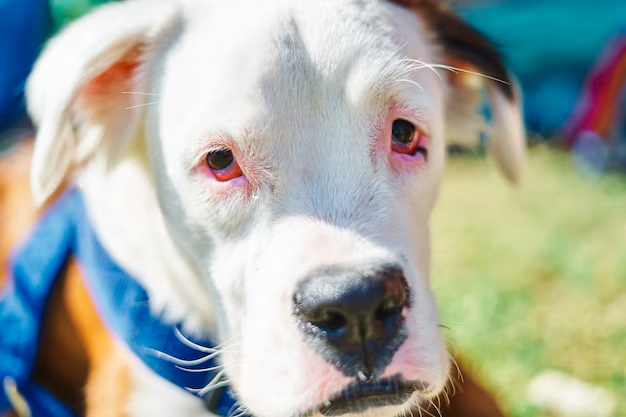Is Your Dog Developing Cataracts? Here's How to Tell
Dogs, much like humans, experience changes as they age. One change pet owners might notice is in their pet's eyes. Cataracts are a common issue in older dogs and can significantly impact their quality of life. But how can you recognize cataracts in your dog, and what can you do to help them? Read on to explore the signs, causes, and options available for dealing with cataracts in dogs.
🐶 Understanding Cataracts in Dogs
Cataracts occur when there is a clouding of the lens in the dog’s eye, which can impair vision. This cloudiness blocks light from entering the eye, making it difficult for the dog to see clearly. Identifying cataracts early can help in managing the condition and maintaining your dog's quality of life.
What Causes Cataracts in Dogs?
Several factors can contribute to the development of cataracts in dogs. Understanding these can help you recognize potential risk factors in your pet:
Genetics: Certain breeds are more prone to cataracts due to hereditary factors. Breeds like the Boston Terrier, Cocker Spaniel, and Bichon Frise are just a few examples.
Age: Aging dogs are more susceptible to cataracts, as the lens in the eye can naturally degrade over time.
Health Conditions: Diseases such as diabetes can increase the likelihood of developing cataracts. Diabetic cataracts can occur rapidly, sometimes overnight.
Eye Injuries: Trauma or injury to the eye can lead to the development of cataracts.
Nutrition and Environment: Poor nutrition and exposure to harmful chemicals or radiation may also play a role.
Recognizing the potential causes can empower pet owners to take preventive measures where possible and be vigilant in monitoring their pets for signs of vision changes.
🔍 Symptoms: How to Spot Cataracts in Dogs
Detecting cataracts early is crucial in managing the condition effectively. Here are key signs to watch for:
Visible Changes in the Eye
- Cloudiness or Opacity: The most noticeable sign is a blue, gray, or white cloudiness in the dog's eye, particularly the lens.
- Redness and Inflammation: While cataracts themselves aren't painful, they can lead to inflammation which might cause redness or irritation.
Changes in Behavior
- Bumping into Objects: Dogs with impaired vision may struggle to navigate their environment, leading to collisions with furniture and walls.
- Hesitation with Stairs or Jumping: If your pet seems suddenly reluctant to climb stairs or jump onto furniture, this could indicate vision issues.
- Difficulty Finding Food and Toys: A sudden change in their ability to locate familiar objects can suggest vision impairment.
Observational Tips
- Regularly check your dog’s eyes during grooming sessions.
- Observe their behavior in different environments and lighting conditions.
🐾 How to Proceed if You Suspect Cataracts
If you suspect that your dog has cataracts, consider the following steps:
👩⚕️ Seek Veterinary Consultation
A veterinary consultation is crucial for an accurate diagnosis. A thorough examination can differentiate cataracts from other possible issues like glaucoma or nuclear sclerosis, which can appear similar but have different implications and treatments.
Diagnostic Tests
- Eye Examination: A vet can perform a detailed eye examination, sometimes using specialized equipment, to assess the extent and type of cataracts.
- Blood Tests: These can help identify underlying conditions such as diabetes that might be contributing to eye problems.
- Ultrasound: In cases where the view of the eye's interior is obscured, an ultrasound might be used to assess the overall health of the eye.
When to Consider Surgery
Cataract surgery is a common treatment, aiming to restore partial or full vision to the affected eye. Here are some considerations for surgical intervention:
- Impact on Life Quality: If cataracts severely impair your dog's vision and quality of life, surgery might be a beneficial option.
- Overall Health: The dog should be in good health to withstand anesthesia and the surgical procedure.
- Age and Breeds: Younger dogs or those with inherited cataracts are often better candidates for surgery.
Consulting with a veterinary ophthalmologist can provide insights into whether surgery might be the right choice for your pet.
🌟 Managing Cataracts Without Surgery
Not all dogs with cataracts need surgery. Here are ways to support a dog living with cataracts:
Adapt Your Home Environment
- Consistent Arrangement: Keep furniture and belongings in familiar places to help your dog navigate more safely.
- Use Texture and Scents: Non-skid mats or scented markers can help guide your dog through specific areas in the house.
Monitor and Adjust Diet
- Balanced Nutrition: Ensuring your dog gets a balanced diet can support overall eye health.
- Supplements and Antioxidants: Discuss with your vet whether any supplements could be beneficial for eye health.
Regular Check-Ups
- Routine visits to the vet can help monitor the progression of cataracts and ensure that related complications are caught early.
🗒️ Quick Reference Guide
Here's a handy summary of what to remember regarding cataracts in dogs:
👀 Symptoms to Watch:
- Cloudiness in the eyes
- Bumping into objects
- Reluctance with stairs or unfamiliar places
🏥 Steps to Take:
- Schedule a vet appointment for diagnosis
- Consider options like surgery if recommended
- Manage home environment and diet for comfort
💡 Tips for Care:
- Consistently arrange furniture
- Provide a balanced diet
- Regular check-ups for eye health
Cataracts can be a challenging issue for both dogs and their owners, but with early detection and careful management, it is possible to maintain a good quality of life for your furry friend. Regular vet visits and attentive care are key to helping your dog navigate this condition successfully.
